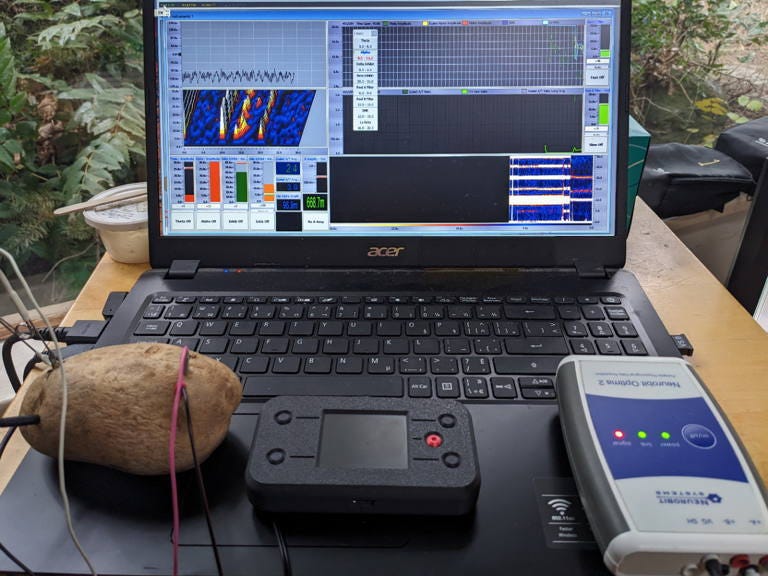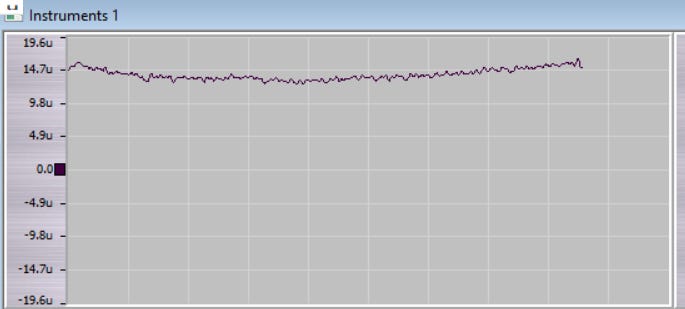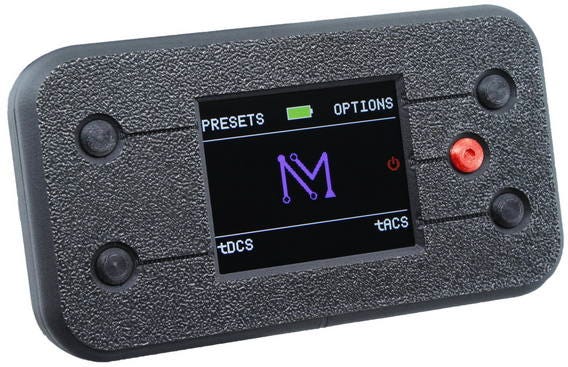Would You Like Trans-Cranial Stimulation with Your Potato?
Trans-cranial Electrical Stimulation is gaining recognition. It’s cheap, harmless, and effective.
“The idea that a weak electrical stimulus, applied outside the head, can meaningfully affect neural activity is often regarded as mysterious.”
— Krause, Vieriera, and Pack (2023). Neuroscientists.
Headaches
There are many kinds of headaches of various types and causes. As a sufferer, we don’t have much insight aside from the nature of the pain, its duration, and location. There are big differences between vascular, tension, sinus, dehydration, and other headaches, but from an insider's perspective they’re just varieties of hurt, all out of our immediate control.
There are thousands of folk remedies, from the ridiculous to the plausible. Even with modern science and the internet, few people understand their headaches.
A poultice involves applying something to your skin. Aside from lotions, we don’t use many poultices anymore. In fact, with the rise of pharmaceuticals, we don’t have many internal cures that we apply to our skin.
Potatoes
European folk medicine suggests applying a slice of potato to your head as a headache remedy. Healthline (2025) tells us, “There is no current scientific research suggesting that raw potato cuttings can effectively treat migraine when applied topically.” We laugh at the ignorance of folk doctors!
But potatoes carry an electric charge, and applying a DC voltage across one’s temples will, in fact, work to remedy certain vascular and tension headaches. Let’s look at what modern science tells us about the potato remedy.
“In 46 AD, the Roman physician Scribonius Largus reported that headaches and chronic pain could be cured by placing a certain kind of fish near the affected area.”
— Krause, Vieriera, and Pack (2023).
Do not forget that observations are not the same as speculations. Observations of potatoes applied to the head should not be dismissed just because “official science” has not done the research and does not understand it. Most scientific discoveries come out of left field.
I put a potato on my electroencephalograph, a machine designed for measuring brainwaves. I found a solid 14.7 microvolt (15 x 10**-6 volts) potential and maximum 2 milliamp (2 x 10**-3 amps) current between the potatoes’ two ends. The potato is electrically charged and its tissue acts like a resistor, but you destroy these features when you cook it.
There is a current flowing when you put two thick slices of raw potato on either side of your head. The power delivered by such a potato is (1.5 x 10**-5 V)x(2 x 10**-3 A) = 3x10**-8 Watts. A potato is a battery.
Transcranial Electrical Stimulation
Electrically stimulating the brain was a curiosity in the 19-th century, explored soon after batteries were discovered by Galvani in 1800 (Rothwell 2018). People had no idea electricity had any therapeutic use, aside from Mary Shelley perhaps.
"Perhaps a corpse would be reanimated; galvanism had given a token of such things."
— Mary Shelley, author of Frankenstein
In 1938, ten sessions of 0.2 second electrical stimulation, each inducing a seizure, successfully precipitated the long-term recovery of a disorganized schizophrenic. This soon led to the first ElectroConvulsive Therapy, or ECT, in 1940. ECT proved effective for a variety of psychiatric conditions including depression (Suleman 2020).
These experiments were done with direct current, but alternating current was also explored with particular focus on coordinating its frequency with that of your brainwaves. The direct current applications are called Transcranial Direct Current Stimulation, or tDCS. The alternating version is given by the acronym tACS.
Direct versus alternating currents have different roles and effects on the brain, according to current theories. It is claimed that direct current can enhance those processes in the brain’s tissues that develop a similar electrical gradient. This is different from ElectroConvulsive therapy which is designed to be entirely disruptive.
The current used for ECT is meant to destroy neural patterns, and the voltages are 10,000 times greater than what’s used for transcranial stimulation. ECT is the neural equivalent of breaking a badly healed bone in order to reset it.
In contrast, Transcranial direct current therapy uses a voltage that’s smaller than what occurs in the brain and, in this way, it can be supportive. When I set my NeuroMyst tDCS machine set at 0.1 mA it generates 30 microvolts, for a total power of 3 x 10**-9 watts.
It should be noted in passing that the $300 NeuroMyst machine produces 1/10-th the maximum power output of my 50 cent potato. So, if you’re interested in trying tDCS, start with a 1” thick, full width slice of potato. Here’s where you should place them on your scalp, according to the NeuroMyst manual (2025). For technical details regarding transcranial stimulation see Woods et al. (2016).
Because each potato slice has different polarities on either side, mark the slices to indicate which sides point forward. You want to apply opposite sides at the two locations on your scalp.
More easily, use the two ends of the vegetable laying the cut ends against your skin. One potato end will act as the anode, the source of the current, and the other as the cathode, which will receive the current. Make sure you’re using opposite sides, but you won’t know which is the anode or the cathode.
Unless you have an ammeter, you won’t know which side gives the positive or negative current for any slice, you'll have to try both ways against your scalp. Give it some time, and use your intuition to feel the difference. Use fresh potatoes and leave them in place for 5 to 20 minutes.
The $300 NeuroMyst will tell you the polarity of the contacts. A cheap ammeter, costing less than $10, will tell you the direction of the current.
Alternating Current
tACS, or transcranial alternating current stimulation, is designed to entrain brain function. While direct current therapy is intended to excite or inhibit cortical activity, alternating current therapy is designed to influence brain oscillations to increase, decrease, concentrate, or diffuse them.
It’s supposed that brains think using oscillating electric fields. The fields are generated by the neurons and the oscillations reflect their collective behavior. Different parts of our brains generate different oscillatory patterns, and we believe our brains use these rhythms to coordinate different functions.
This model of brain function is similar to the radio broadcast model. In the radio model, a fundamental oscillating wave is modulated in a way that contains information. The fundamental wave determines the channel, and tuning between waves enables us to distinguish one channel from another. The channel’s information is encoded in the oscillations that are added to this fundamental wave.
No one has shown that the brain operates in this way, but we do see these fundamental oscillations in the brain, and we can associate strength, focus, and consistency of oscillations with certain behaviors.
ECT is a form of electrocution; tACS is a gentle massage. There is still the question of what kind of massage is the right massage because a good massage takes skill. You cannot just call any electrical flogging therapeutic.
The sensible approach is to stimulate the brain at its natural frequencies, to encourage and support natural function. It could well be that someone’s brain oscillates too slowly or too fast, and they’d gain more benefit if you stimulated them at a better frequency. To make things simple, I started by stimulating my brian at its natural frequency of 10 cycles per second, or 10 Hz.
The NeuroMyst
tACS machines are small and inexpensive. Given their few components, they could be priced at $30, the level of a radio controlled toy, but the tACS devices sell to a different audience and are priced at around $300.
A well regarded device that delivers both tACS and tDCS is called the NeuroMyst, made somewhere in the US. The company doesn’t reveal its location on any of its materials, only an email address. This behavior always causes me some concern.
Given the tiny amount of power required, tACS devices are easily powered by a small battery. They’re simply delivering a rhythmic current. Things get more complicated when you start wondering about the different kinds of rhythm.
The simplest biological rhythm is a rhythm that alternately ebbs and flows moving gently between the two. An impulse rhythm that abruptly starts and stops is more complex because it’s composed of layers of higher frequencies. These higher harmonics can have individual, unexpected effects.
In the picture below, the different frequency bands in which the NeuroMyst delivers stimulation are shown by the bright horizontal bands. In this case, the device was set to provide a fundamental 10 hertz stimulation. You can see higher and lower harmonics at 5 hertz intervals.
The Proof and the Pudding
Here’s the result of running a 2-minute tACS session on myself at 10 Hz and 0.5 mA, placing the cathode above my right eye and the anode above my left. On the left side of this graph, you see my brain function that’s being read at the site labeled F4, which is at the top of one’s right forehead. I should note that I’m not using the NeuroMyst here, but a similar device called Neuron Queen made by an Australian-Taiwanese company that’s now out of business..
At the bottom of the graph on the left side you can see a lot of white “fur.” This shows a high level of activation of my brain at frequencies below 3 Hz. You also see intermittent electrical emanations at 10 Hz, in what’s called the alpha band.
Over the 10-minute reading before the stimulation, the voltage I produced in the alpha band averaged 10.0 microvolts. Then you see the bright voltage bands of the stimulation, followed by a minute of my brain’s response after the stimulation stopped.
The three additional readings shown on the right were taken at the same location on my scalp later the same day, two days later, and four days later. On the subsequent readings the average voltage in the alpha band is 10% or higher than my pre-stimulation level. The voltage in the alpha band is more concentrated at 10 Hz. The voltage is also more continuous, with fewer “blue” periods. This alone leads to the higher average voltage.
At the same time my brain’s low frequency activity has decreased. There is less white fur along the bottom of the graphs for the post-stimulation readings. These low frequencies are partly a reflection of broader focus and of a sleepy, quiet mind.
Higher voltages at these low frequencies also reflect the intermittency of the alpha band voltage. That is, they reflect the rhythm at which the alpha frequency is itself ebbing and flowing, which is happening over periods of several seconds.
The higher, more consistent alpha voltage, which has followed this single stimulation, is typical of concentrated, focused thinking. One might call this a more attentive thinking style. One can’t judge this as better or worse, it’s all relative. But this does show that a brief, low-power session of tACS has resulted in a change that we think we understand, and that is enduring.
Is It Worth It?
You might ask, “So, how did you feel?” At first, this seems to be the ultimate question, but the answer in all cases is, “Pretty much the same.” This is to be expected when using this technology because one’s thinking style has no emotion. Thinking produces results, it is not something you can sense out of context.
You might then ask, “What result did you achieve?” I can say that I didn’t feel bad, and that’s important because too much brain stimulation makes you tired and can give you a headache. But aside from having no adverse reaction, nothing seemed to happen.
But again, this may be the wrong question. The question is subjective and, lacking a controlled environment, it’s typically difficult to sense changes in one’s thinking. It could be that after this training I had fewer divergent thoughts, but who keeps track? In my experience in giving brain training to others, the most noticeable changes are in mood over time, and in how other people react to you.
People’s reactions are a sensitive measure of your thoughts and presentation, and I’ve been amazed at the differences that can result from a single session of brain training. One client told me that he felt absolutely no change, but that the next day he continually met people who were happy to see him.
The overall change is a big question, but it’s not my point. My point here is just to tell you about this form of brain stimulation, to show you that it can have an enduring effect, and to orient your expectations.
Small changes can have huge results because our environment is not a stable place. You may feel little difference between going though your day in a different mood, but it can change your life.
At the price of a potato, there is little risk and, after taking these measurements, I ate my potato.
References
Healthline (2025). “Migraine Herbal Home Remedies from Around the World,” at: https://www.healthline.com/health/migraine-herbal-home-remedies-from-around-the-world
Krause M.R., Vieira P.G., and Pack C.C. (2023 Jan 30). “Transcranial Electrical Stimulation: How Can a Simple Conductor Orchestrate Complex Brain Activity?” PLoS Biol. 21(1): e3001973. https://pmc.ncbi.nlm.nih.gov/articles/PMC9886255/
NeuroMyst (2023). NeuroMyst Pro 2023 | The Science of tDCS and tACS,
Rothwell, John (2018 Dec 4). “Transcranial Brain Stimulation: Past and Future.” Brain Neurosci. Adv. 4(2). https://pmc.ncbi.nlm.nih.gov/articles/PMC7058222/
Suleman, Raheem (2020 Sep 10). “A Brief History of Electroconvulsive Therapy.” American Journal of Psychiatry Residents' Journal 16(1). https://psychiatryonline.org/doi/10.1176/appi.ajp-rj.2020.160103
Woods, A. J, Antal, A., Bikson, M., Boggio, P. S., et al. (2016 Feb). “A Technical Guide to tDCS, and Related Non-Invasive Brain Stimulation Tools.” Clinical Neurophysiology 127 (2): 1031-48. https://www.sciencedirect.com/science/article/pii/S1388245715010883











Also: power equals amps times volts. That's all you need to know.
Great! NeuroMyst makes it seem easy to get results, but I don't think it's quite so easy. Getting results takes some finesse. One thing I advise is not to use the device for 20, but for 2 minutes per session. That way you can explore more settings and different montages. Small differences can make big changes. Your brain is a puzzle and everyone is slightly (or largely) different.